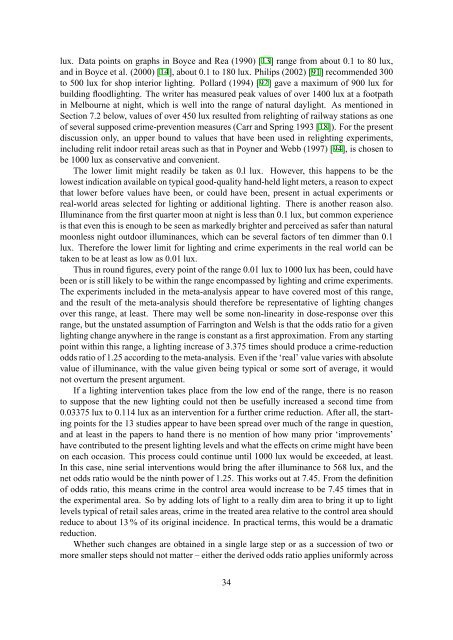outdoor lighting and crime, part 1 - Astronomical Society of Victoria
outdoor lighting and crime, part 1 - Astronomical Society of Victoria
outdoor lighting and crime, part 1 - Astronomical Society of Victoria
Create successful ePaper yourself
Turn your PDF publications into a flip-book with our unique Google optimized e-Paper software.
lux. Data points on graphs in Boyce <strong>and</strong> Rea (1990) [13] range from about 0.1 to 80 lux,<br />
<strong>and</strong> in Boyce et al. (2000) [14], about 0.1 to 180 lux. Philips (2002) [91] recommended 300<br />
to 500 lux for shop interior <strong>lighting</strong>. Pollard (1994) [92] gave a maximum <strong>of</strong> 900 lux for<br />
building flood<strong>lighting</strong>. The writer has measured peak values <strong>of</strong> over 1400 lux at a footpath<br />
in Melbourne at night, which is well into the range <strong>of</strong> natural daylight. As mentioned in<br />
Section 7.2 below, values <strong>of</strong> over 450 lux resulted from re<strong>lighting</strong> <strong>of</strong> railway stations as one<br />
<strong>of</strong> several supposed <strong>crime</strong>-prevention measures (Carr <strong>and</strong> Spring 1993 [18]). For the present<br />
discussion only, an upper bound to values that have been used in re<strong>lighting</strong> experiments,<br />
including relit indoor retail areas such as that in Poyner <strong>and</strong> Webb (1997) [94], is chosen to<br />
be 1000 lux as conservative <strong>and</strong> convenient.<br />
The lower limit might readily be taken as 0.l lux. However, this happens to be the<br />
lowest indication available on typical good-quality h<strong>and</strong>-held light meters, a reason to expect<br />
that lower before values have been, or could have been, present in actual experiments or<br />
real-world areas selected for <strong>lighting</strong> or additional <strong>lighting</strong>. There is another reason also.<br />
Illuminance from the first quarter moon at night is less than 0.1 lux, but common experience<br />
is that even this is enough to be seen as markedly brighter <strong>and</strong> perceived as safer than natural<br />
moonless night <strong>outdoor</strong> illuminances, which can be several factors <strong>of</strong> ten dimmer than 0.1<br />
lux. Therefore the lower limit for <strong>lighting</strong> <strong>and</strong> <strong>crime</strong> experiments in the real world can be<br />
taken to be at least as low as 0.01 lux.<br />
Thus in round figures, every point <strong>of</strong> the range 0.01 lux to 1000 lux has been, could have<br />
been or is still likely to be within the range encompassed by <strong>lighting</strong> <strong>and</strong> <strong>crime</strong> experiments.<br />
The experiments included in the meta-analysis appear to have covered most <strong>of</strong> this range,<br />
<strong>and</strong> the result <strong>of</strong> the meta-analysis should therefore be representative <strong>of</strong> <strong>lighting</strong> changes<br />
over this range, at least. There may well be some non-linearity in dose-response over this<br />
range, but the unstated assumption <strong>of</strong> Farrington <strong>and</strong> Welsh is that the odds ratio for a given<br />
<strong>lighting</strong> change anywhere in the range is constant as a first approximation. From any starting<br />
point within this range, a <strong>lighting</strong> increase <strong>of</strong> 3.375 times should produce a <strong>crime</strong>-reduction<br />
odds ratio <strong>of</strong> 1.25 according to the meta-analysis. Even if the ‘real’ value varies with absolute<br />
value <strong>of</strong> illuminance, with the value given being typical or some sort <strong>of</strong> average, it would<br />
not overturn the present argument.<br />
If a <strong>lighting</strong> intervention takes place from the low end <strong>of</strong> the range, there is no reason<br />
to suppose that the new <strong>lighting</strong> could not then be usefully increased a second time from<br />
0.03375 lux to 0.114 lux as an intervention for a further <strong>crime</strong> reduction. After all, the starting<br />
points for the 13 studies appear to have been spread over much <strong>of</strong> the range in question,<br />
<strong>and</strong> at least in the papers to h<strong>and</strong> there is no mention <strong>of</strong> how many prior ‘improvements’<br />
have contributed to the present <strong>lighting</strong> levels <strong>and</strong> what the effects on <strong>crime</strong> might have been<br />
on each occasion. This process could continue until 1000 lux would be exceeded, at least.<br />
In this case, nine serial interventions would bring the after illuminance to 568 lux, <strong>and</strong> the<br />
net odds ratio would be the ninth power <strong>of</strong> 1.25. This works out at 7.45. From the definition<br />
<strong>of</strong> odds ratio, this means <strong>crime</strong> in the control area would increase to be 7.45 times that in<br />
the experimental area. So by adding lots <strong>of</strong> light to a really dim area to bring it up to light<br />
levels typical <strong>of</strong> retail sales areas, <strong>crime</strong> in the treated area relative to the control area should<br />
reduce to about 13 % <strong>of</strong> its original incidence. In practical terms, this would be a dramatic<br />
reduction.<br />
Whether such changes are obtained in a single large step or as a succession <strong>of</strong> two or<br />
more smaller steps should not matter – either the derived odds ratio applies uniformly across<br />
34
















